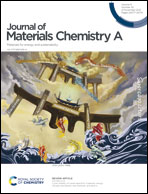Organic–inorganic hybrid-reinforced flexible and robust 2D papers for high-efficiency microwave-absorbing films†
Abstract
Developing flexible microwave-absorbing film with efficient electromagnetic (EM) response and practicability is of great importance. However, it is still a big challenge for microwave-absorbing films to exhibit excellent EM response ability, good mechanical properties, and fine multifunctional features at the same time. Herein, novel microwave-absorbing papers (MAPs) are designed based on a facile poly(vinyl pyrrolidone)-assisted vacuum filtration assembly to take full advantage of the natural physical properties of carbon nanotubes and reduced graphene oxide. The constructed laminated papers not only keep the original performance characteristics of the conductive components, but also have new functionality by component integration and microscopic structure formation. Based on that, the minimum reflection loss value of MAPs is −49.6 dB at 1.5 mm and the effective absorption bandwidth reaches 6.2 GHz at 1.6 mm. Meanwhile, the optimum RCS reduction value reaches 17.5 dB m2 when the detection theta was set as 0°. Moreover, integrated functionalities are revealed in the MAPs, such as good flexibility, high tensile strength, light feature, having the nature of writing papers, machinability in architectures, and potential as thermal-protective coatings, demonstrating great potential for applications as microwave-absorbing devices or wearable smart electronics.



 Please wait while we load your content...
Please wait while we load your content...